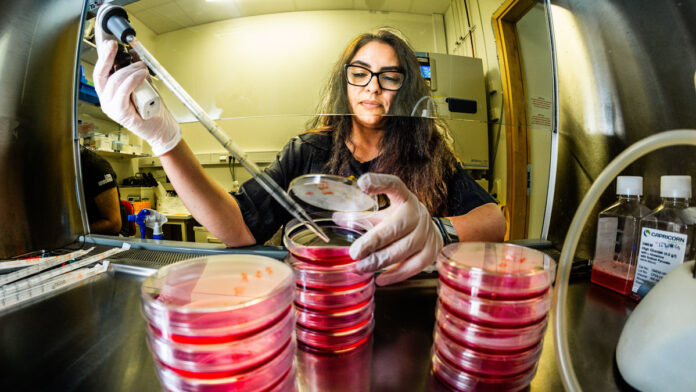
Researchers have uncovered a previously unknown mechanism that safeguards the chromosome ends from being mistakenly repaired by the cell.
While DNA repair is vital for survival, attempts to repair the chromosome ends – called telomeres – can have catastrophic outcomes for cells. The research, published in Nature, increases the understanding of how cancer and certain rare diseases develop. It was led by researchers at Linköping University in Sweden and the Institute of Cancer Research in the UK.
Cells constantly monitor their DNA. A DNA helix that ends abruptly is a signal that DNA has been severely damaged – at least in most cases.
“The most severe DNA damage a cell can suffer is when a DNA helix breaks up in two pieces,” said Francisca Lottersberger, associate professor at Linköping University.
Normally, the cells would try to promptly repair all damage to DNA. The dilemma is that chromosomes have ends that look like broken DNA. If cells were to “repair” them, looking for another loose end to join them with, this would lead to the fusion between two or more chromosomes, making the cell susceptible to transform into a cancer cell.
Therefore, the telomeres need to be protected from the cell’s DNA repair machinery.
“I’m very interested in the fact that the cells have to constantly repair DNA damages to avoid mutations, cell death, and cancer, while at the same time, they must not repair the chromosome ends by mistake since that would result in the same catastrophic outcome. What’s the difference between damaged DNA and the natural chromosome end? This problem has been known from almost a century, but some aspects are still not completely resolved,” Lottersberger said.
Although the telomeres are not to be repaired as if they were broken DNA, several DNA repair proteins can be found at the chromosome ends. Lottersberger’s research team has previously shown that a key repair protein, DNA protein kinase (called DNA-PK) helps in processing telomeres and in protecting them from degradation. But how DNA-PK at the same time is prevented from trying to repair these blunt DNA ends remained a mystery until now.
In collaboration with Max Douglas at the Institute of Cancer Research in the UK, the researchers have shown that two other proteins, RAP1 and TRF2, have an important role to play in regulating DNA-PK.
“We show genetically, biochemically and structurally how the protein RAP1, brought to telomeres by TRF2, ensure by direct interaction that DNA-PK doesn’t ‘repair’ the telomeres,” Lottersberger, who led the genetic part of the study, said.
The role of telomeres in processes such as cancer development and aging, and what happens when they do not work properly, has long interested scientists. Diseases caused by disturbances in telomere maintenance are rare, but very serious, and include premature aging, blood cell deficiency called aplastic anaemia and fibrosis in the lungs.
In about half of cases, the disease is explained by a known mutation that affects telomere stability, but in many cases, there is currently no known medical explanation for why the individual is sick. Lottersberger hopes their findings will help in defining the biological mechanism behind more unexplained cases.
The research is also relevant in cancer research. On one hand, inappropriate “repair” of telomeres can trigger catastrophic events leading to the accumulation of mutations and cancer. On the other hand, cancer cells are often less efficient at repairing damage to DNA compared to normal cells. This weakness is exploited in cancer treatments and many therapies kills tumour cells by causing DNA damage or inhibiting repair, or both.
Knowledge of how cells regulate DNA repair and protect telomeres has a bearing on both prevention and treatment of cancer. Increased understanding of which proteins play key roles in these cellular processes can contribute to more precise and targeted treatment strategies.
Jim Cornall is editor of Deeptech Digest and publisher at Ayr Coastal Media. He is an award-winning writer, editor, photographer, broadcaster, designer and author. Contact Jim here.

